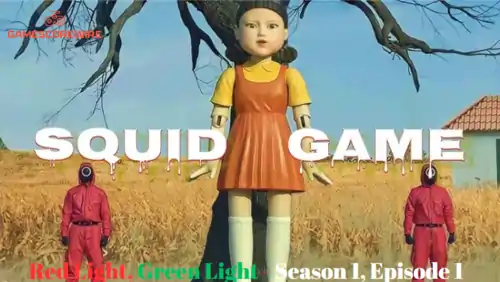
Table of Contents
Introduction
The global sensation Squid Game captivated audiences with its high-stakes survival games and powerful social commentary. The first episode, “Red Light, Green Light,” introduces viewers to the deadly competition where contestants must navigate simple childhood games turned sinister. This game sets the tone for the series, offering a glimpse into the horrors and challenges the players will face.
Overview of ‘Red Light, Green Light’
Basic Rules
“Red Light, Green Light” is a simple yet chilling game. Players must move forward when the phrase “Green Light” is called and freeze when “Red Light” is announced. The challenge lies in staying perfectly still, as any detected movement results in instant elimination—a euphemism for death in this context. A giant animatronic doll scans for movement with unerring precision, leaving no room for error. Players must cross the finish line within a strict time limit to survive.
Purpose in the Show
As the opening game, “Red Light, Green Light” is pivotal in establishing the deadly stakes of the competition. It tests the players’ ability to follow rules and introduces them to the brutal consequences of failure. This sets the stage for the life-or-death struggles that define the series.
Key Entities and Elements
The Giant Doll
At the heart of the game is the iconic giant doll, a haunting figure with an unsettling presence. Equipped with motion sensors, the doll plays a central role in detecting movement. Beyond its function, the doll holds cultural significance, drawing from Korean childhood games. Its design, resembling a traditional Korean schoolgirl, adds an eerie nostalgia to the game.
The Players
The contestants of Squid Game come from diverse backgrounds, united by desperation and crushing debt. This diversity highlights their varied reactions during the game. Some freeze in fear, others panic and run, while a few strategize to increase their odds of survival. These reactions provide a stark look at human behavior under extreme stress.
The Guards and Overseers
The guards, clad in red uniforms and masks, enforce the rules with chilling efficiency. Their anonymity dehumanizes them, emphasizing the loss of individuality in this dystopian setting. The overseers, including the enigmatic Front Man, oversee the proceedings, heightening the atmosphere of control and surveillance.
Challenges and Dangers
Standing Completely Still
One of the game’s greatest challenges is maintaining complete stillness. Under the gaze of the doll, even the slightest movement—a trembling hand or a startled step—can result in death. This aspect heightens the psychological tension as players struggle to control their fear and impulses.
Unpredictable Factors
Chaos ensues as players react unpredictably. Some panic and flee, causing chain reactions that lead to others’ deaths. In one notable moment, players pushing others to gain an advantage underscores the ruthless fight for survival. The unpredictability of human behavior adds an additional layer of danger.
Psychological Impact
The game’s brutality leaves lasting scars on the players. The sight of mass executions and the realization of their mortality create a harrowing emotional burden. This psychological toll is a recurring theme throughout the series, as players grapple with the moral implications of their actions.
Comparison to Real-Life ‘Red Light, Green Light’
In its innocent form, “Red Light, Green Light” is a beloved childhood game, evoking memories of play and laughter. Squid Game transforms this nostalgia into horror by twisting the familiar into something deadly. This stark contrast between innocence and violence underscores the series’ commentary on the loss of humanity in the pursuit of survival.
Symbolism and Themes
Social Commentary
“Red Light, Green Light” reflects the desperation of individuals in a society marked by inequality. The players, driven by financial ruin, participate in a deadly competition, mirroring the struggles of the marginalized in the real world. The game’s design highlights the dehumanization of the players, reducing them to mere entertainment for the elite.
Morality and Survival
The game introduces viewers to the moral dilemmas faced by the players. Should they help others or prioritize their own survival? These questions resurface throughout the series, showcasing the ethical complexity of the characters’ decisions.
Impact on Viewers
“Red Light, Green Light” gripped audiences with its graphic violence juxtaposed with the innocence of a childhood game. The episode’s shocking conclusion left viewers stunned, eager to see what lay ahead. The combination of suspense, social commentary, and emotional depth made this game an unforgettable opening to Squid Game.
Final Thoughts
“Red Light, Green Light” is more than just the first game in Squid Game—it’s a masterful introduction to the series’ themes of survival, morality, and societal critique. By blending nostalgia with horror, the game sets the tone for the challenges to come and leaves an indelible mark on both the players and the audience.
Disclaimer: This article is for informational and entertainment purposes only. It contains discussions of fictional content from the television series Squid Game and may include descriptions of graphic violence and mature themes. Reader discretion is advised. All rights to the series and its elements belong to their respective creators and copyright holders.








